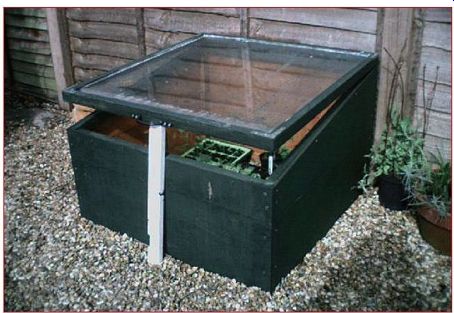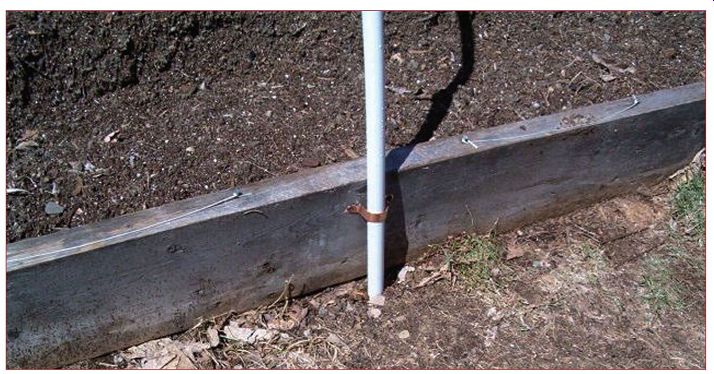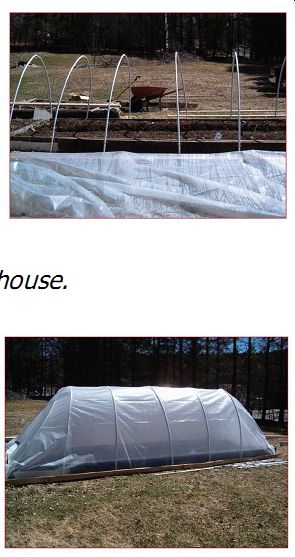While season extension isn't an absolute necessity for the mini-farmer, it has some advantages. The most obvious is that season extension will allow you to grow warm season crops like sweet potatoes that require more growing days than available in your area, but there are other less obvious advantages.
A simple, unheated hoop house, constructed with two layers of plastic, will allow many crops, such as parsnips and carrots, to be stored in the ground rather than harvested in fall. It will also allow many biennial plants, such as cabbage, to successfully overwinter for purposes of seed production. Finally, it will allow you to grow many cold-hardy crops for sale or consumption, such as spinach and other salad greens. Along with these more practical benefits comes the psychological value (for us northeastern farmers) that such a structure will have in midwinter when the inviting growing foliage can be seen inside against a backdrop of dismal snow.
There are a lot of approaches to season extension ranging from simple cold frames to fancy heated greenhouses with specialized glass and framing. The approach to this, as with everything else in mini-farming, is economic.
Cold frames are simple, four-sided rectangles that are open on the bottom and sloped on the top and oriented so that the downward end of the slope faces the sun. Usually, they are covered with old windows, so they can be made cheaply. The only heat provided is that of the sun, so they can be placed just about anywhere. A cold frame will provide a temperature about 20 degrees warmer than the outside air during the day but will drop to within 5 degrees of outside temperature overnight unless it is well insulated or has provisions for heat retention. If raised beds are used, cold frames can easily be made to fit.
Hotbeds are cold frames that have a mechanism for heating built in. A couple of hundred years ago, hotbeds were made by digging a pit three feet deep, filling it to within six inches of the top with fresh horse manure that would provide heat as it composted and then covering that with six inches of regular garden soil in which crops were planted. More modern hotbeds use either buried heating cables underneath where the plants grow or pipes carrying warm water . Obviously, hotbeds keep crops warmer than cold frames, but the amount of warmth they provide varies with design.

------------ A cold frame can extend the season by several weeks.
The unheated hoop house is a simple skeleton framework of hoops covered with the kind of plastic that folks in the northern parts of the United States use to cover their windows during the winter . Because it holds a far greater volume of air , it will tend to provide more warmth than a cold frame. There are a number of hoop house kits available from companies such as Hoop House Greenhouse Kits (www.hoophouse.com), and the most expensive of these cost less than $1,000. For farmers who are handy, there are also a number of free plans available on the Internet, including an easily built and inexpensive structure designed by Travis Saling viewable at westsidegardener.com. The pvcplans .com Web site has a number of free plans available describing how to make greenhouses from PVC pipe.
The idea of an unheated environment that gets all of its heat from the sun can be taken further to create a solar greenhouse. Unlike a hoop house, which is translucent on all sides, a solar greenhouse is translucent only on the side facing the sun, and the other sides are insulated to retain heat while drums of water painted black sit against the back wall creating a solar mass. Portions of the back wall are often reflective to put more light onto the plants. A solar greenhouse is certainly more expensive to construct than a hoop house, but it has the advantage of having smaller ongoing operational costs than a traditional greenhouse because it doesn't use supplemental heating.
Either a hoop house or a solar greenhouse can be made into a heated greenhouse by adding supplemental heat. Supplemental heat can be provided by a heating appliance of practically any type compatible with your budget.
What to Grow
The decision on what to grow decides the design of the season extension adopted, rather than the other way around. Miner's lettuce grows only a couple of inches tall, so it will work fine in a cold frame, but kale is so tall that a hoop house would be required.
Winter-hardy crops like spinach and kale don't require supplemental heat, lettuce would require only a little, and tender crops like tomatoes would require a considerable amount. Especially with increasing fuel costs, it is important to consider whether growing frost-tender crops like tomatoes in the winter makes economic sense, and most often it does not.
I recommend growing hardy crops using no supplemental heat or semihardy crops using just enough supplemental heat to prevent freezing. Under such conditions, growth of crops is slow, and it is best to establish them late in the summer or early in the fall so that by the time winter hits, the season extender is serving mainly to extend the harvest rather than actively grow crops.
So what crops are suitable for this purpose? Carrots, parsnips, and parsley will do well in a hoop house or cold frame. Both parsnips and carrots started at midsummer will taste sweet come January. Salsify planted just at the first fall frost can be harvested a bit past Yule. Many leaf lettuces will grow, though their outer leaves may sustain some damage. (Try the Winter Density variety.) Beets will hold in the ground in a cold frame, and chard may grow if you are south of Pennsylvania. Kale will hold well and even grow, as will Brussels sprouts and green onions or leeks. (The American Flag variety of leek will work well.) Both Brunswick and January King cabbage can be harvested around New Year's if planted midsummer.
There are a few particularly cold-hardy crops ideal for season extension, including miner's lettuce, corn salad (a.k.a. "mache"), italian dandelion, wintercress, and purslane. While these are unusual, they are a real taste-treat that adds character to winter salads.
Besides winter crops, an unheated hoop house can also help the farmer get a head start on spring season crops and even extend the season long enough to grow crops or varieties that would otherwise be impossible, such as the aforementioned sweet potatoes in the Northeast. A hoop house also expands the possibilities for cover crops and green manures because of the change in environment.
Special Considerations
A hoop house, cold frame, or hotbed is inherently protected from precipitation. The good news is water is completely in the farmer's control. The bad news is the lack of rainfall will tend to concentrate salts in the soil in the protected area, which will hurt plant growth.
It takes three or four years for this to happen, but it is still a problem. Another problem with a more permanent structure is that the space within it can accumulate pests and diseases. Especially since pests have nowhere to go, the enclosed area can cancel some of the benefits of crop rotation within that space.
The most space-efficient way to handle this is to make the structure easily erected and dismantled, and dismantle it late every spring. For more permanent greenhouse designs, the plastic can be removed during the late spring through early fall, which would have the same effect. For large structures, such as 90-foot-long greenhouses, it is obviously too time-consuming, but for structures of the size usually employed in a mini-farm, it is will be feasible if they are designed with easy maintenance in mind.
Larger farms in Europe and the United States have movable greenhouses on rails that are rolled from one location to another with each season to accommodate growing needs and diminish the problems of a permanent standing structure. This may be a bit beyond the needs of a mini-farmer , but it can be accomplished with a little ingenuity and moderate expense by a farmer who is so inclined.
Improving Greenhouse Efficiency
An unheated hoop house can do a great deal to extend the growing season, but a few simple modifications at very low cost can dramatically improve the light and heat utilization of such a structure.
In the winter when the sun is low in the sky, a good proportion of the light that hits a hoop house will enter the south side and exit the north side without ever touching a plant.
If a reflective sheet is installed along the entire north wall up to the ridge pole, light that would otherwise escape will get reflected back onto the plants, thus increasing the light available to the plants and raising the temperature. A good material for this purpose is reflective insulation, available inexpensively from most home improvement stores. Not only will the aluminum surface of the insulation reflect light, but it will also reflect 97% of radiant heat that would have escaped through the plastic back into the hoop house.
The next modification is to add a method of heat retention. A simple hoop house will lose temperature quickly after sunset, and one way to slow down the temperature drop is to line up a number of black-painted barrels against the north wall of the hoop house- though not actually touching the reflective insulation-and fill them with water . The drums of water will absorb the heat from the sunlight during the day and then radiate that heat back into the hoop house at night. The value of this approach is enhanced by the addition of the reflective insulation because the radiant heat gets reflected back into the enclosed space from all directions. Barrels can be emptied and moved anytime the greenhouse is moved, or they can be used for raising fish, with exchanged water being used as nitrogen-rich liquid fertilizer . (Yes, fish can be raised in a barrel using the technology of aquaculture, but aquaculture isn't covered in this guide.) So, what happens if there is no sun for a week and the water drums freeze? South of Connecticut, this is unlikely to be a problem, but it is a possibility further north. You may need to abandon using barrels or abandon the simple hoop house design altogether and build a solar greenhouse. There are a number of solar greenhouse designs available on the Internet. What they all have in common is significant insulation (R-30) everywhere but in the windows that face south and reflective coating on all interior walls.
Portable Hoops for Raised Beds
Raised beds lend themselves to easily constructed and inexpensive attachments for season extension, particularly if constructed with a width of four feet. The easiest attachments are cold frames mentioned earlier and portable hoops.

----------- Loops on the frame of a raised bed.
Raised beds can be equipped to accept portable hoops by attaching 1-inch rings to the outside of the beds at the ends and every two feet.
The portable hoops are made from 10-foot-long pieces of 1/2 inch PVC pipe that have been cut in half for ease of storage. To build the hoops, the two 5-foot pieces of PVC are connected via a straight coupling, and then each end is inserted into one of the 1 inch rings on each side of the bed. The hoops are covered with translucent plastic sheeting 10 feet wide available at any hardware store. The plastic can be secured at the long edges by sandwiching it between 1-inch × 2-inch boards so it can be easily rolled up and deployed, or it can by secured with homemade snap clips made by slicing pieces of garden hose lengthwise. Which technique will work best depends on the strength of prevailing winds in your area.

-------- Insert the PVC pipes into the loops.
--------- Completed hoop house.
----